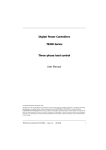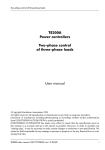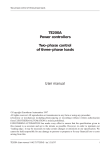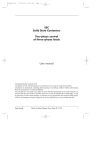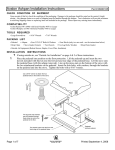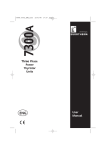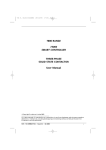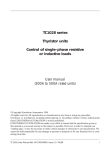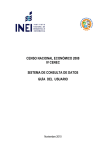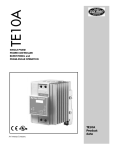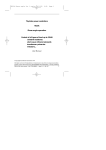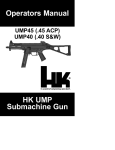Download Digital Power Controllers TE300 Series Three - Elektro
Transcript
Digital Power Controllers TE300 Series Three-phase load control User Manual ©Copyright Eurotherm Automation 1996 All rights reserved. All reproduction or transmission in any form or using any procedure (electronic or mechanical, including photocopying or recording) without written authorisation from EUROTHERM AUTOMATION is strictly prohibited. EUROTHERM AUTOMATION has made every effort to ensure that the specification given in this manual is as accurate and up to the minute as possible. However, in order to maintain our 'leading edge', it may be necessary to make certain changes or omissions to our specification. We cannot be held responsible for any damage to persons or property or for any financial loss or costs arising. TE300 User manual HA175437ENG Issue 2 i TE300 USER MANUAL CONTENTS EUROPEAN DIRECTIVES . . . . . . . . . . . . . . . . . . . . . . . . . . . . . . . . .iv CE MARKING AND SAFETY . . . . . . . . . . . . . . . . . . . . . . . . . . . . . . .iv ELECTROMAGNETIC COMPATIBILITY (EMC) . . . . . . . . . . . . . . . . . . .iv DECLARATION OF CE CONFORMITY . . . . . . . . . . . . . . . . . . . . . . . .v PRECAUTIONS . . . . . . . . . . . . . . . . . . . . . . . . . . . . . . . . . . . . . . . .vi Chapter 1 IDENTIFYING THE CONTROLLERS . . . . . . . . . . . . . . . . . . . . . . . .1-2 GENERAL INTRODUCTION TO THE TE300 SERIES . . . . . . . . . . . . .1-2 TECHNICAL SPECIFICATION . . . . . . . . . . . . . . . . . . . . . . . . . . . .1-5 PRODUCT CODE . . . . . . . . . . . . . . . . . . . . . . . . . . . . . . . . . . . . .1-7 EXAMPLE OF PRODUCT CODE . . . . . . . . . . . . . . . . . . . . . . . . . . .1-8 SERIAL NUMBER LABELS . . . . . . . . . . . . . . . . . . . . . . . . . . . . . . . .1-8 Chapter 2 INSTALLATION . . . . . . . . . . . . . . . . . . . . . . . . . . . . . . . . . . . . . . .2-2 INSTALLATION - SAFETY . . . . . . . . . . . . . . . . . . . . . . . . . . . . . . . .2-2 DIMENSIONAL DETAILS . . . . . . . . . . . . . . . . . . . . . . . . . . . . . . . .2-3 MOUNTING DETAILS . . . . . . . . . . . . . . . . . . . . . . . . . . . . . . . . . .2-5 Chapter 3 WIRING . . . . . . . . . . . . . . . . . . . . . . . . . . . . . . . . . . . . . . . . . . . .3-2 WIRING - SAFETY . . . . . . . . . . . . . . . . . . . . . . . . . . . . . . . . . . . . .3-2 POWER WIRING . . . . . . . . . . . . . . . . . . . . . . . . . . . . . . . . . . . . . .3-3 USER TERMINAL BLOCKS . . . . . . . . . . . . . . . . . . . . . . . . . . . . . . .3-7 ii TE300 User manual Chapter 4 CONFIGURATION . . . . . . . . . . . . . . . . . . . . . . . . . . . . . . . . . . . .4-2 CONFIGURATION - SAFETY . . . . . . . . . . . . . . . . . . . . . . . . . . . . .4-2 DRIVER BOARD CONFIGURATION . . . . . . . . . . . . . . . . . . . . . . . .4-3 Chapter5 OPERATION . . . . . . . . . . . . . . . . . . . . . . . . . . . . . . . . . . . . . . . . .5-2 THYRISTOR FIRING MODES . . . . . . . . . . . . . . . . . . . . . . . . . . . . .5-2 CONTROL OPERATION . . . . . . . . . . . . . . . . . . . . . . . . . . . . . . . .5-8 Chapter 6 COMMISSIONING PROCEDURE . . . . . . . . . . . . . . . . . . . . . . . . . .6-2 COMMISSIONING PROCEDURE - SAFETY . . . . . . . . . . . . . . . . . .6-2 CHECKING THE CHARACTERISTICS . . . . . . . . . . . . . . . . . . . . . . .6-3 POWERING UP THE CONTROLLER . . . . . . . . . . . . . . . . . . . . . . . .6-4 Chapter 7 MAINTENANCE . . . . . . . . . . . . . . . . . . . . . . . . . . . . . . . . . . . . . .7-2 FUSES . . . . . . . . . . . . . . . . . . . . . . . . . . . . . . . . . . . . . . . . . . . . .7-2 SERVICING . . . . . . . . . . . . . . . . . . . . . . . . . . . . . . . . . . . . . . . . .7-4 TOOLS . . . . . . . . . . . . . . . . . . . . . . . . . . . . . . . . . . . . . . . . . . . .7-4 TE300 User manual iii EUROPEAN DIRECTIVES CE MARKING AND SAFETY TE300 products carry the CE mark in compliance with the essential requirements of the European Low Voltage Directive 73/23/EC of 19/2/73 (amended by the Directive 93/68/EC of 22/7/93). For safety reasons, TE300 products installed and used in compliance with this User Manual meet the essential requirements of the European Low Voltage Directive. ELECTROMAGNETIC COMPATIBILITY (EMC) For an industrial environment only, must not be used in domestic environments Eurotherm certifies that TE300 products, installed and used in compliance with this User Manual, meet the following EMC test standards and enable the system which incorporates them to comply with the EMC Directive, as far as the TE300 products are concerned. EMC test standards Immunity Standards : EN 50082-2, EN 61000-4-2, EN 61000-4-3, EN 61000-4-4, EN 61000-4-6, ENV 50204 Emission Standards : EN 50081-2, EN 55011 class A, EN61800-3 (second environment) Internal EMC filters EMC filters are incorporated in the TE300 to reduce conducted emission in accordance with the test standard. EMC Guide In order to help you reduce the effects of electromagnetic interference depending on the product installation, Eurotherm can supply you with the 'Electromagnetic Compatibility' Installation Guide (ref: HA025464). This guide lists the rules generally applicable for EMC. iv TE300 User manual DECLARATION OF CE CONFORMITY Availability A declaration of CE conformity is available on request. Validation by Competent Body Eurotherm has validated the compliance of TE300 products with the European Low Voltage Directive and EMC test standards through product design and laboratory testing. The tests carried out on TE300 products are listed in a Technical Construction File validated by the LCIE (Central Laboratory for the Electrical Industries), a Recognised Competent Body. Further information For any further information, or if in doubt, please contact Eurotherm Controls where qualified staff are available to advise or assist you with the commissioning of your installation. TE300 User manual v PRECAUTIONS Safety symbols Important safety precautions and special information are indicated in the text of the manual by two symbols: This symbol means that failure to take note of the information given in this manual may have serious consequences for the safety of personnel and may even result in electrocution. DANGER This symbol means that failure to take note of the information may · have serious consequences for the installation or · lead to the incorrect operation of the power unit ATTENTION These symbols must be observed for particular points. However the whole of the manual remains applicable. Personnel The installation, configuration, commissioning and maintenance of the power unit should only be carried out by personnel qualified and trained to work with low voltage electrical equipment in an industrial environment. Independent alarm Given the value of the equipment controlled by TE300 products it is the responsibility of the user, and it is highly recommended, that an independent safety device (alarm) should be installed. This alarm must be tested regularly. Eurotherm can supply suitable equipment. vi TE300 User manual Chapter 1 IDENTIFYING THE CONTROLLERS Contents GENERAL INTRODUCTION TO THE TE300 SERIES . . . . . . . .1-2 TECHNICAL SPECIFICATION . . . . . . . . . . . . . . . . . . . . . . .1-5 PRODUCT CODE . . . . . . . . . . . . . . . . . . . . . . . . . . . . . . . .1-7 EXAMPLE OF PRODUCT CODE . . . . . . . . . . . . . . . . . . . . . .1-8 SERIAL NUMBER LABELS . . . . . . . . . . . . . . . . . . . . . . . . . . .1-8 TE300 User manual 1-1 Chapter 1 IDENTIFYING THE CONTROLLERS GENERAL INTRODUCTION TO THE TE300 SERIES The TE300 series of controllers are thyristor units designed to control the electrical power of industrial three-phase loads. A TE300 series controller is made up of three channels, each comprising a pair of thyristors connected in anti-parallel. The TE300 series is designed to control three-phase resistive loads: · elements with a low temperature coefficient · short-wave infrared elements Three-phase loads can be connected: · in star with or without neutral · in open or closed delta The wiring of the controller is indifferent to the order of the supply phase rotation. The nominal line-to-line voltage can be selected from 230V to 500V. The nominal currents of the TE300 series controllers are between 16A and 63A, per phase, defined at an ambient temperature of 45°C. 70 I (A) I = 63 A (fan-cooled) N eff I = 50 A N (fan-cooled) 60 50 I = 40 A N 40 30 I = 25 A N 20 I = 16 A N 10 Ambient temperature (°C) 0 20 25 30 35 40 45 50 55 60 70 Figure 1-1 Current derating per phase as a function of ambient temperature (dotted line: current limit for recommended fuse) Attention! In order to allow for variations in load resistance, the calculated current should not exceed 0.8 times the maximum rated current of the unit. The load current is calculated from the supply voltage and the load power (or resistance). 1-2 TE300 User manual Heatsink Supply terminal block T E 3 00 E UR O T L1 C1 5V + 7 8 H E RM L2 C2 ε Auxiliary power supply connector (option) L3 C3 ON 9 Thyristor firing Control connector Load terminal block Figure 1-2 Overview of the TE300 series controller TE300 User manual 1-3 The unit is controlled by analogue or logic signals. The input analogue signals have two possible voltage ranges: 0 to 5V or 0 to 10V and a current range of: 4 to 20mA. The input logic signals have the following nominal values: 5V, 10V or 20mA. Local control is possible via a potentiometer or external contacts. (The input must be configured as 0 to 5V code 0V5) The 5V,0.5mA user-voltage output on terminal 7 and 9 is intended for this purpose. The electronics of the TE300 controllers are self-supplied from the power voltage and do not require external connections. The control method of the TE300 series includes line voltage squared (V2) compensation for line variations in the range +10% to -15% of the nominal voltage of the controller. TE300 series controllers have several thyristor firing modes: - Logic ON-OFF - Cycle time modulation (Burst-firing with four possible cycle times) - Advanced Single-cycle (firing by complete cycles separated by a complete number of half-cycles of non-firing). Thyristor firing ensures the absence of any DC component in load currents when connected in open delta or in star with neutral configurations. . A TE300 series controller is equipped with: · A ‘driver board’ which generates thyristor firing pulses, implements control and provides power for the electronics. This board is also used for the signal and operating mode configurations · A ‘filter board’ to ensure Electromagnetic Compatibility in accordance with the test standard and to protect the controller from transient interference. The filters which provide immunity against electromagnetic interference are located: · Between the power phases · Between the phases and the safety earth connector The user terminal block below the controller is used for the control signal connection without having to open the front door of the unit. A green LED indicating thyristor firing (‘ON’) is located on the front facia. TE300 power controllers are designed to be bulkhead or DIN rail mounted. The 63A rated limit must be permanently fan-cooled. The fan power supply of either 115V or 230V should be specified when ordering the controller. 1-4 TE300 User manual TECHNICAL SPECIFICATION The TE300 series of controllers is intended for thyristor regulation and control of an industrial three-phase load. Power Nominal current (per phase) Line-to-line voltage Supply frequency Dissipated power Insulation (1 min test) Cooling Fan power supply (63 amp unit) Load Supply phases Load configuration 16A, 25A, 40A, 50A or 63A (at 45°C) 230V to 500V (+10%, -15%) 50Hz and 60Hz (±2Hz) automatic selection 1.3W (approx.) per amp, per phase. Fuses are external to TE300 and will produce 0.7W (approx) per amp per phase. 2000Vac between power and earth and 3600Vac between power and control Natural convection for 16A, 25A, 40A ratings Permanent fan-cooling for 50A and 63A rating 115V or 230V (to be specified) 13VA Resistive three-phase load with a low temperature coefficient or short-wave infrared elements Wiring independent of the phase rotation order Closed delta (3-wire) or open (6-wire) Star without neutral (3-wire) or with neutral (4-wire) Load configuration set by ‘coffee beans’ CE Marking Electrical safety TE300 controllers carry the CE mark in compliance with the essential requirements of the European Low Voltage Directive 73/23/EC (amended by the Directive 93/68/EC) Electromagnetic compatibility Immunity and Emissions TE300 products comply with Electromagnetic Compatibility test standards (see page iv). Control External control signal Input impedance Configuration Local control TE300 User manual Analogue (in Burst-firing and Single-cycle modes): voltage 0 to 5V or 0 to 10V; current 4 to 20mA Logic (ON/OFF mode), nominal levels: voltage 5V or 10V; current 20mA On state ≥ 50% and off state ≤ 25% of the nominal level Voltage input: ≥100kΩ, current input: 250Ω ‘Coffee beans’ on driver board 10kΩ potentiometer supplied by the user-voltage ‘Dry’ contact for logic operation Input configured as 0 to 5V 1-5 Thyristor firing Firing modes Switching Indication ON/OFF (Logic) Burst-firing mode Number of firing cycles at 50% of configurable power: 1, 8, 16 or 128 cycles Advanced Single-cycle (load in star with neutral or open delta) Firing by complete cycles separated by half-cycles of nonfiring without DC component One cycle of firing and one cycle of non-firing at 50% power Conduction starts and ends at zero voltage Thyristor firing is signalled by a green LED Control performance Control type Linearity Stability The power controlled in the load (simulated by voltage squared V2) is proportional to the setpoint Better than ±2% of the full scale With variations: · Of the supply voltage +10%, -15% · Of the temperature from 0 to 40°C stability is better than ±2% of full scale Options Auxiliary power supply Possibility of operation for non-standard three-phase mains by supplying the electronics separately from the power at 115V or 230V Environment Operating temperature Storage temperature Thyristor protection Protection External wiring Operating atmosphere Humidity Pollution 0°C to +45°C at maximum altitude of 2000m -10°C to +70°C High-speed external fuses (except for short-wave infrared application) Internal MOVs (varistors) and RC snubbers IP20 on the front facia (in compliance with Standard IEC529) To be carried out in compliance with standard IEC 364 Non-explosive, non-corrosive, non-conductive RH: 5% to 95%, non-condensing Pollution degree 2 permissible, defined by IEC 664 In order to maintain its 'leading edge', Eurotherm may have to make changes to its specifications without advance notice. For any further information, or if in doubt, please contact Eurotherm Controls. 1-6 TE300 User manual PRODUCT CODE TE300/Current/Voltage/Cooling/Signal/Firing/Configuration/Mounting/Language/Options/00 Nominal current 16 amps 25 amps 40 amps 50 amps* 63 amps* Code 16A 25A 40A 50A 63A * Fan cooled Mains voltage* (line-to-line) 230 volts 240 volts 277 volts 380 volts 400 volts 415 volts 440 volts 480 volts 500 volts Code 230V 240V 277V 380V 400V 415V 440V 480V 500V Fan supply Code Without fan-cooling (16A to 40A) 000 With fan-cooling (50A & 63A): 115V 115V 230V 230V Input signal 0 to 5 volts 0 to 10 volts 4 to 20 milliamps Code 0V5 0V10 4mA20 Thyristor firing mode Logic ON/OFF Burst-firing: 1 cycle 8 cycles 16 cycles 128 cycles Advanced Single-cycle (4- or 6-wire configuration) Code LGC Load configuration Delta (3-wire) Star without neutral (3-wire) Star with neutral (4-wire) Open delta (6-wire) Code 3D 3S 4S 6D Mounting Bulkhead DIN rail Code BKD DIN Manual language French English German Italian Code FRA ENG GER ITA Options Power supply separate from electronics (non-standard power supply) Code FC1 FC8 C16 128 SCA 115V 230V * Non-standard mains: use the coding for the voltage immediately above and choose option of power supply separated TE300 User manual 1-7 EXAMPLE OF PRODUCT CODE Controller and installation parameters Nominal load current 35 amps Nominal supply voltage 415 volts line-to-line Input signal 0 to 5 volts Firing mode Advanced Single-cycle Load configuration Star with neutral DIN rail mounting DIN User manual In English Controller code: TE300 / 40A / 415V / 000 / 0V5 / SCA / 4S / DIN / ENG / 00 SERIAL NUMBER LABELS An identification label provides all the information relating to the factory settings of the controller. The identification label is located externally on the right side of the unit. EI EUROTHERM 2.20 WORTHING, ENGLAND : 01903 268500 MODEL : TE300/40A/415V/000/0V5/SCA/4S/DIN/ENG/00 SERIAL No. : INT100/002/001/03/99 RANGE : 40A 415V 0F222935 AUX. POWER SUPPLY : SELF-SUPPLIED FAN POWER SUPPLY : NONE INPUT : 0-5V FIRING : ADVANCED SINGLE-CYCLE WIRING ANY NON-SPECIFIED FUSE INVALIDATES GUARANTEE : STAR WITH NEUTRAL : FERRAZ B093910 Figure 1.3 Example of identification label for a TE300 controller The information corresponds to the product code example Attention! Following any re-configuration on the part of the user, there is no guarantee that the controller will corespond to the label information. 1-8 TE300 User manual TE300 series controllers may be mounted: MOUNTING DETAILS Fan-cooled controllers 63A rating TE300 controllers have permanent fan-cooling Weight of fan-cooled TE300 controller: 3.5kg The overall dimensions of the fan-cooled TE300 controller are given in Figure 2-2. Figure 2-2 Dimensions of fan-cooled TE300 controller (63A rating) TE300 User manual 1-9 Chapter 2 INSTALLATION Contents INSTALLATION - SAFETY . . . . . . . . . . . . . . . . . . . . . . . . . . .2-2 DIMENSIONAL DETAILS . . . . . . . . . . . . . . . . . . . . . . . . . . .2-3 NON FAN-COOLED CONTROLLERS . . . . . . . . . . . . . . . . .2-3 FAN-COOLED CONTROLLERS . . . . . . . . . . . . . . . . . . . . . .2-4 MOUNTING DETAILS . . . . . . . . . . . . . . . . . . . . . . . . . . . . .2-5 DIN RAIL MOUNTING . . . . . . . . . . . . . . . . . . . . . . . . . . . .2-5 BULKHEAD MOUNTING . . . . . . . . . . . . . . . . . . . . . . . . . . .2-6 TE300 User manual 2-1 Chapter 2 INSTALLATION INSTALLATION - SAFETY DANGER! TE300 units must be installed by personnel qualified and trained to work with low voltage electrical equipment in an industrial environment. Units must be installed in electrical cabinets correctly fan-cooled to ensure that condensation and pollution are excluded. The cabinet must be closed and bonded to the safety earth in accordance with Standards NFC 15-100, IEC 364 or current national Standards. For installations which are fan-cooled, it is recommended that a fan-failure detection device or a thermal safety cut-out should be fitted in the cabinet. TE300 units may be bulkhead or DIN rail mounted. The units must be mounted with the heatsink positioned vertically, with no obstructions above or below which could inhibit or impede airflow. If several units are mounted in the same cabinet, they should be arranged in such a way that air expelled from one cannot be drawn into the unit located above it. Attention! The units are designed to be used at an ambient temperature less than or equal to 45°C. Leave a minimum gap of 5cm between two units placed side by side. Excessive overheating of the controller may lead to incorrect operation of the unit. This may in turn cause damage to the components. 2-2 TE300 User manual DIMENSIONAL DETAILS Non fan-cooled controllers The overall dimensions of non fan-cooled TE300 controllers (16A to 40A ratings) are given in Figure 2-1. Protective cover Power terminal block 100 40 57 22 TE300 EUROTHERM ε L1 L2 L3 C1 C2 C3 215 ON 7 8 9 22 141 186 12 Control terminal block Power terminal block Safety earth terminal Figure 2-1 Dimensions of non fan-cooled TE300 controllers Weight of non fan-cooled TE300 controller: 3.1kg TE300 User manual 2-3 Fan-cooled controllers 50A and 63A rating TE300 controllers have permanent fan-cooling Weight of fan-cooled TE300 controller: 3.5kg The overall dimensions of the fan-cooled TE300 controller are given in Figure 2-2. Power terminal block Protective cover 100 40 57 22 TE300 EUROTHERM ε L1 L2 L3 C1 C2 C3 233 Safety earth terminal ON 7 8 9 22 Fan Fan Power terminal block 92 92 Fan supply Power terminal block 12 Control terminal block 141 186 Figure 2-2 Dimensions of fan-cooled TE300 controller (50A and 63A rating) 2-4 TE300 User manual MOUNTING DETAILS TE300 series controllers may be mounted: · On DIN rails (code DIN) · On a bulkhead (code BKD) DIN rail mounting TE300 controllers are designed to be mounted on two DIN rails EN 50022. AA AA AAAA AAAAA AA AA AA AAAAA AA AA AAAAA AAA AA AA AAAAA AAA AA AAAAA AA AAAAA AA AAAAA AA AAAAA AAA A AAAAA AAA AAA AA AAAAA AA AAAAA AA AAAAA AA AAAAA AA AAAAA AA AA AAAAA AA AA AAAAA AA AAA AA AAA AA AA AAAAA AAA AA AAAAA Lip 1 Upper DIN rail AAAA AAAA TE300 Fixing plate 125 ±0·5 mm 2 Lower DIN rail Fixing clip Figure 2-3 DIN rail mounting for TE300 controller To mount the TE300 controller on DIN rails (see Figure 2-3). 1. Offer up the unit by first engaging the two lips on the upper part of the fixing plate (back plate of controller) on to the upper DIN rail. 2. Clip the controller (by spring clips) on to the lower DIN rail, making sure that the clip is properly engaged. TE300 User manual 2-5 Bulkhead mounting TE300 controllers may be bulkhead mounted. Two fixing plates are provided for this type of mounting For this type of mounting use the following instructions: · Drill three holes for M6 screws following the dimensions given in Figure 2-4 · Fix the upper plate on to the panel using the oblong hole at the top of the controller · Install the lower plate with two M6 screws · Insert the fixing lugs of the controller into the lower plate · Slightly undo the central screw holding the upper plate in order to slide it upwards, position the controller and slide the plate back down into the slots on the heatsink. Tighten the central screw. AA AA 208+1 AA AA AA AA AA AA AA AA AA AA 3 holes for M6 screws Fixing plates AA 120 Upper fixing plate Slot on back of heatsink Lower fixing plate Figure 2-4 Bulkhead drilling and mounting dimensions (in mm) for the T E 3 0 0 controller 2-6 TE300 User manual Chapter 3 WIRING Contents INSTALLATION - SAFETY . . . . . . . . . . . . . . . . . . . . . . . . . . .3-2 WIRING - SAFETY . . . . . . . . . . . . . . . . . . . . . . . . . . . . . . . .3-2 POWER WIRING . . . . . . . . . . . . . . . . . . . . . . . . . . . . . . . . .3-3 CONNECTION . . . . . . . . . . . . . . . . . . . . . . . . . . . . . . . . .3-3 POWER WIRING DIAGRAMS . . . . . . . . . . . . . . . . . . . . . . . .3-3 STAR WITHOUT NEUTRAL AND CLOSED DELTA CONFIGURATION . . . . . . . . . . . . . . . . . . . . . . . . . . . . . . .3-4 STAR WITH NEUTRAL CONFIGURATION . . . . . . . . . . . . . . .3-5 OPEN DELTA CONFIGURATION . . . . . . . . . . . . . . . . . . . . .3-6 USER TERMINAL BLOCKS . . . . . . . . . . . . . . . . . . . . . . . . . .3-7 GENERAL INTRODUCTION . . . . . . . . . . . . . . . . . . . . . . . .3-7 EXTERNAL INPUT WIRING . . . . . . . . . . . . . . . . . . . . . . . . .3-8 CONTROL WIRING IN LOCAL MODE . . . . . . . . . . . . . . . . .3-9 POWER SUPPLY SEPARATE FROM ELECTRONICS (OPTION) 3-10 TE300 User manual 3-1 CHAPTER 3 WIRING WIRING - SAFETY DANGER! Wiring must only be carried out by personnel who are qualified to work in a low voltage industrial environment. It is the user’s responsibility to wire and protect the installation in accordance with current professional Standards. A suitable device ensuring electrical isolation between the equipment and the supply must be installed upstream of the unit in order to permit safe operation. TE300 series units have a protective cover. DANGER! Before any connection or disconnection, ensure that power and control cables or leads are isolated from voltage sources. For safety reasons, the safety earthing cable must be connected before any other connection is made during wiring and it should be the last cable to be disconnected. The safety earth is connected to the screw located on the slot at the side of the controller and is denoted by the symbol: Attention! To ensure correct grounding of the TE300 unit, make sure that it is mounted on the reference ground surface (panel or bulkhead). Failing this, it is necessary to add a ground connection at most 10cms long between the earth connection and the reference ground surface. DANGER! This connection, which is intended to ensure good ground continuity, can never be used to replace the safety earth connection. 3-2 TE300 User manual POWER WIRING Connection The power terminal blocks (mains and load) are cage terminal blocks. The control terminal block has a plug-in screw connector. The safety earth is connected to an M8 screw and bolt. The terminal capacities and tightening torques to be observed are given in Table 3-1. Parameter Power & load supply Safety earth Control Terminal capacity (mm2) 10 to 25 10 to 25 1.5 Tightening torque (Nm) 2 12.5 0.7 Table 3-1 TE300 controller connection details The cross-section of the conductors to be used must comply with Standard IEC 943. Power wiring diagrams The TE300 power wiring diagram depends on the load configuration. The following three power and safety earth wiring diagrams are given below to illustrate different types of load configuration. TE300 User manual 3-3 Star without neutral and closed delta configuration Three-phase loads connected in star without neutral or in closed delta are configured as 3-wire. L1 L2 L3 Line protection and mains circuit breaker (installed by user) AA AA A AAAAA TE300 Thyristor protection highspeed fuses (except for short-wave infrared application) EUROTHERM ε L1 L2 L3 C1 C2 C3 Safety earth ON AAAAAAA AAAAAAA C1 Control input C2 3-wire load 0·5A fuse in each wire connected to a phase C3 115 V or 230 V fan supply (50A & 63A rating only) Figure 3-1 Power and safety earth wiring for a load connected in ‘star without neutral’ or in ‘closed delta’ (3-wire configuration) 3-4 TE300 User manual Star with neutral configuration A three-phase load connected in star with neutral is configured as 4-wire. L1 L2 L3 N Line protection and mains circuit breaker (installed by user) AA A AA AAAAA Thyristor protection highspeed fuses (except for short-wave infrared application) EUROTHERM ε TE300 L1 L2 L3 C1 C2 C3 Safety earth ON Control input AAAAAAAA AAAAAAAA AAAAAAAA 0·5A fuse C1 C2 C3 115 V or 230 V Fuse in each wire connected to a phase Fan supply (50A & 63A rating only) 4-wire load Figure 3-2 Power and safety earth wiring for a load connected in ‘star with neutral’ (4-wire configuration) TE300 User manual 3-5 Open delta configuration Important! The load wiring given below must be observed. L1 L2 L3 Line protection and mains circuit breaker (installed by user) Thyristor [protection highspeed fuses (except for short-wave infrared applications) A AA AA AAAAA TE300 EUROTHERM ε L1 L2 L3 C1 C2 C3 Safety earth ON Control input AAAAAAAAA AAAAAAAAA AAAAAAAAA 0·5A fuse C1 6-wire load C2 C3 115 V or 230 V C4 C5 Fuse in each wire connected to a phase Fan supply (50A & 63A rating only) C6 Figure 3-3 Power and safety earth wiring for a load connected in ‘open delta’ (6-wire configuration) 3-6 TE300 User manual USER TERMINAL BLOCKS General introduction The user terminal blocks comprise: · A control terminal block · A fan terminal block (for the 50A and 63A rating) · An auxiliary power supply terminal block (option). The control terminal block is located below the controller on the left side. The fan terminal block is located below the controller on the right side. The auxiliary power supply terminal block is located above the controller on the right side (option). These connectors for the wires plug in. Terminal numbers (label) Function 7 User output +5V (for wiring manual control potentiometer) 8 Control input (signal +ve) 9 Control 0V 10 & 12 Power supply separate from electronics (option) 11 Not used 115V or 230V Fan supply (50A and 63A rating) Table 3-2 Function of user terminals Control terminal block 7 8 9 Front fascia of controller LOAD Figure 3-4 Control terminal block (view of controller from below) TE300 User manual 3-7 External input wiring The external control signal can be: · Analogue for Burst-firing and Single-cycle thyristor firing modes · Logic for ON/OFF mode of operation. The external signal must be connected to the control terminal block between terminal 8 (‘+ Input’) and terminal 9 (‘0V’). This input is configured by means of the ‘coffee beans’, solder linked pads Eurotherm 2000 series controller AA AA AA AA AAAAA EUROTHERM 1A fuse 2216 Mains phase L N Mains neutral 1A fuse if second phase E Safety earth V+ V- 1A 1B Thermocouple input Analogue (or + logic) output Control signal 0V + Control signal connector LOAD 7 8 View of TE300 controller from below 9 Figure 3-5 External control signal wiring 3-8 TE300 User manual Control wiring in local mode The controller can be driven in local mode by a potentiometer or by a ‘dry’ contact. For operation with manual control, a 10kΩ external potentiometer must be used, connected between terminals 9 (‘0V’) and 7 (‘+5V’, 0.5mA). The potentiometer wiper is connected to the control terminal block input (terminal 8). 10 k 100% Potentiometer 0% Control signal connector User +5V + 0V LOAD 7 8 View of TE300 controller from below 9 Figure 3-6 Manual control wiring using an external potentiometer For operation in logic mode (ON/OFF) contacts can be connected between terminals 8 (‘+ Input’) and 7 (‘+5V’). Contacts (for example, relay output of 2216 controller) User +5V Control signal connector LOAD 7 8 View of TE300 controller from below 9 Figure 3-7 Contact wiring for logic operation TE300 User manual 3-9 Power supply separate from electronics (option) TE300 controllers can be used with non-standard mains. If a TE300 series controller is used with a mains supply, the voltage of which is not shown in the voltage codes, the control electronics must be fed separately from the power by 115V or 230V supply. The separate power supply must be connected between terminals 10 and 12 (terminal 11 is not used). The auxiliary power supply must be in phase with the power voltage between phases 1 & 2 (power terminals L1 & L2) L1 L2 L3 Line protection and mains circuit breaker (installed by user) AAAAAA AAAAAA Non-standard mains Thyristor protection highspeed fuses (except for short-wave infrared application) 0·5A fuses Must be in phase with L1 - L2 115 V or 230 V Connecteur du signal de commande View of TE300 controller from above 10 11 12 Figure 3-8 Connection of power supply separate from electronics (option) Attention! Each auxiliary power supply feed wire connected to a supply phase must be protected by a 0.5A fuse. 3-10 TE300 User manual TE300 User manual 3-11 Chapter 4 CONFIGURATION Contents CONFIGURATION - SAFETY . . . . . . . . . . . . . . . . . . . . . . . .4-2 DRIVER BOARD CONFIGURATION . . . . . . . . . . . . . . . . . . .4-3 GENERAL INTRODUCTION . . . . . . . . . . . . . . . . . . . . . . . .4-3 LOCATION OF ‘COFFEE BEANS’ (SOLDER PADS) . . . . . . . .4-4 CONFIGURING FOR THE TYPE OF LOAD CONNECTION . .4-5 CONTROL SIGNAL CONFIGURATION . . . . . . . . . . . . . . . .4-6 THYRISTOR FIRING MODE CONFIGURATION . . . . . . . . . . .4-6 TE300 User manual 4-1 Chapter 4 CONFIGURATION CONFIGURATION - SAFETY The controller is configured by soldered ‘coffee beans’, located on the driver board. Important! The controller is supplied fully configured in accordance with the product code on the identification label and is ready for operation after wiring. This chapter is included with a view to: · Checking that the configuration is suitable for the application · Modifying, if necessary, certain characteristics of the controller on site. DANGER! For safety reasons, re-configuration of the controller using the ‘coffee beans’ must be carried out with the unit switched off and by personnel qualified and trained to work with electrical equipment in a low voltage industrial environment. Before starting the re-configuration procedure, ensure that the controller is isolated and that any accidental power-up is not possible. After re-configuring the controller, amend the codes on the identification label to prevent any later maintenance problems. 4-2 TE300 User manual DRIVER BOARD CONFIGURATION General introduction The ‘coffee beans’ located on the driver board are used to configure: · The type of load connection · The type and level of the control signal · The thyristor firing mode · The ‘Elimination of DC component’ option. The functions of the ‘coffee beans’ on the driver board are summarised in the following table. Function ‘Coffee beans’ Type of load configuration GS7, GS6 Thyristor firing mode GS1, GS2 GS3, GS4 Type and level of control signal GE1, GE2, GE3 Table 4-1 Function of ‘coffee beans’ on driver board ‘Coffee beans’ GR1 to GR4 are used for factory settings and are not intended to be re-configured by the customer. Important! In the ‘coffee bean’ configuration tables X : denotes the corresponding solder link (‘coffee bean’) - denotes absence of (open) solder link. TE300 User manual : 4-3 Location of ‘coffee beans’ GR4 GR3 LED1 GR1 GR2 GE3 GS7 GS6 GS5 GS4 Firing mode configuration GS3 Input signal configuration GS1, GS2 GS2 GE1, GE2, GE3 GE2 GS1 GE1 GS6 and GS7 GS3, GS4 Burst firing length configuration GS5 Load connection configuration Not used Figure 4-1 Location of configuration ‘coffee beans’ on the driver board (solder-side view) The ‘coffee beans’ are labelled GR, GE or GS, depending on their function. 4-4 TE300 User manual Configuring the type of load connection The controller is configured for the type of load connection by means of ‘coffee beans’ GS6 and GS7 located on the driver board. Load configuration Code ‘Coffee beans’ GS6 GS7 Star without neutral (3-wire) 3S - - Closed delta (3-wire) 3D - X Star with neutral (4-wire) 4S X - Open delta (6-wire) 6D X X Table 4-2 Configuration of load connection type TE300 User manual 4-5 Control signal configuration The three ‘coffee beans’ GE1 to GE3 are used to configure the controller input. Type and range of control signal Voltage ‘Coffee beans’ 0 to 5V analogue & ‘5V’ logic GE1 GE2 GE3 - - - 0 to 10V analogue & ‘10V’ logic - X - Current 4 to 20mA analogue & ‘20mA’ logic X - X Local control 10kΩ potentiometer (0 to 5V) - - - ‘Dry’ controller relay contacts (0 to 5V) - - - Table 4-3 Control signal configuration using ‘coffee beans’ Thyristor firing mode configuration The firing mode is configured by soldering ‘coffee beans’ GS1 & GS2. In Burst-firing mode the number of firing cycles is configured by ‘coffee beans’ GS3 & GS4 (this number is given for the cycle corresponding to 50% power). Thyristor firing mode Coffee beans’ GS1 GS2 GS3 GS4 Logic (All or nothing) - - - - Burst-firing 1 cycle X - - - 8 cycles X - X - 16 cycles X - - X 128 cycles X - X X X X - - Advanced Single-cycle (4- or 6-wire load configuration) Table 4-4 Thyristor firing mode configuration 4-6 TE300 User manual Chapter 5 OPERATION Contents THYRISTOR FIRING MODES . . . . . . . . . . . . . . . . .5-2 GENERAL INTRODUCTION . . . . . . . . . . . . . . . . .5-2 ‘BURST-FIRING’ MODE . . . . . . . . . . . . . . . . . . . . .5-3 ‘SINGLE-CYCLE’ MODE (‘1-CYCLE BURST-FIRING’)5-5 ‘ADVANCED SINGLE-CYCLE’ MODE . . . . . . . . . .5-6 ‘LOGIC’ MODE . . . . . . . . . . . . . . . . . . . . . . . . . .5-7 CONTROL OPERATION . . . . . . . . . . . . . . . . . . . .5-8 TE300 User manual 5-1 Chapter 5 OPERATION THYRISTOR FIRING MODES General introduction TE300 controllers have the following thyristor firing modes: · Burst-firing with configurable cycle time · Advanced Single-cycle (firing by cycles and non-firing by half-cycles) · Logic (ON/OFF). As an option, DC component elimination for 3-wire configuration is available in Burst-firing and Logic modes. They can be re-configured by the user, as described in the chapter entitled ‘Configuration’. 5-2 TE300 User manual ‘Burst-firing’ mode Burst-firing mode is a duty cycle mode which consists of supplying a series of complete mains voltage cycles to the load. Load voltage t 0 TNF TF TM Figure 5-1 ‘Burst-firing’ mode (TF - firing time; TM - modulation time) Thyristor firing and non-firing are synchronised with the mains and, for a resistive load, are performed at zero voltage for each load. This type of firing eliminates steep rates of voltage applied to the load, minimises interference to the supply network and, above all, avoids generating radio frequency interference (RFI). In ‘Burst-firing’ mode, the power delivered to the load depends on the firing time TF and the non-firing time TNF. The load power is proportional to the firing ratio (τ) which is defined by the ratio of the firing time TF to the modulation time TM = TF + TNF The firing ratio or duty cycle is expressed by the following ratio: TF τ = ---------------TF + TNF The load power can be expressed by: P = τ . PMAX Where PMAX represents the load power for full thyristor firing. The length of the cycle in basic Burst-firing is selected by the user from four values: 1, 8, 16 and 128 which are the number of thyristor firing cycles at 50% power. This value is configured at the factory, when the controller is ordered. TE300 User manual 5-3 The modulation time in ‘Burst-firing’ mode is variable according to the power demand. For example, for ‘8-cycle Burst-firing’: · At 50% power, the typical value of the modulation time is 0.32s (at 50Hz): 8 firing and 8 non-firing cycles. · For a setpoint less than 50%, the firing time remains constant (8 cycles), the non-firing time increases and, as a consequence, the modulation time increases. · For a setpoint greater than 50%, the non-firing time remains constant (8 cycles), the firing time increases and, as a consequence, the modulation time increases. The control system adjusts the basic Burst-firing modulation time in order to retain optimum accuracy irrespective of the power demand. As a result of this type of modulation, TE300 offers precision control which adapts to each particular setpoint zone. AAAAAAAAAAA AAAAAAAAAAAA AAAAAAAAAAA AAAAAAAAAAAA AAAAAAAAAAA AAAAAAAAAAAA AAAAAAAAAAA AAAAAAAAAAAA AAAAAAAAAAA AAAAAAAAAAAA AAAAAAAAAAA AAAAAAAAAAAA AAAAAAAAAAA AAAAAAAAAAAA AAAAAAAAAAA AAAAAAAAAAAA AAAAAAAAAAA AAAAAAAAAAAA AAAAAAAAAAA AAAAAAAAAAAA AAAAAAAAAAA AAAAAAAAAAAA AAAAAAAAAAA AAAAAAAAAAAA AAAAAAAAAAA AAAAAAAAAAAA AAAAAAAAAAA AAAAAAAAAAAA AAAAAAAAAAA AAAAAAAAAAAA AAAAAAAAAAA AAAAAAAAAAAA AAAAAAAAAAA AAAAAAAAAAAA AAAAAAAAAAA AAAAAAAAAAAA AAAAAAAAAAA AAAAAAAAAAAA AAAAAAAAAAA AAAAAAAAAAAA AAAAAAAAAAA AAAAAAAAAAAA AAAAAAAAAAA AAAAAAAAAAAA 6s 5s TM Modulation time 4s 3s 2s TF 1s = TNF = 160 ms Power distribution 0 25% 50% 75% 100% Figure 5-2 Modulation time as a function of power (example: ‘8-cycle Burst-firing’) 5-4 TE300 User manual ‘Single-cycle’ mode (‘1-cycle Burst-firing’) This Burst-firing mode has a single firing cycle or a single non-firing cycle and is called ‘Singlecycle’ (or ‘standard Single-cycle’) firing mode. Load voltage t 0 TF TM TNF 50% power TF = TNF t 0 TF TM TNF 25% power TNF = 3 TF t 0 0 TF TM TNF 75% power TF = 3 TNF Figure 5-3 ‘Single-cycle’ firing mode At 50% power, the modulation time in ‘Single-cycle’ mode is 40ms: - 1 firing cycle (20ms at 50Hz) 1 non-firing cycle (20ms at 50Hz) For a setpoint less than 50%: - The firing time remains constant (1 cycle) The non-firing time increases and, as a consequence, The modulation time increases For a setpoint greater than 50%: - The non-firing time remains constant (1 cycle) The firing time and the modulation time increase. TE300 User manual 5-5 ‘Advanced Single-cycle’ mode In order to minimise power fluctuation during the modulation period, the ‘advanced Singlecycle’ thyristor firing mode uses: · A complete number of cycles for firing · A complete number of half-cycles for non-firing Load voltage Standard Single-Cycle (1 cycle Burst-firing) t 0 T NF T F T M Load voltage Advanced Single-cycle t 0 T NF T F T M Figure 5-4 Comparison of ‘Single-cycle’ and ‘advanced Single-cycle’ firing modes (66% power, TF = 2 TNF) At 50% power, and for a setpoint less than 50%, thyristor firing takes place as in the ‘standard Single-cycle’ mode (see page 5-5). For a setpoint greater than 50% in ‘advanced Single-cycle’ mode: · · The non-firing time is constant at one half-cycle Firing takes place over whole cycles. The use of half-cycles for the non-firing time accounts for the reduced cycle time when compared to the ‘standard Single-cycle’ mode. In a ‘short-wave infrared’ application, ‘advanced Single-cycle’ firing mode reduces the brightness of the infrared elements and thus minimises annoying visual flickering. The ‘advanced Single-cycle’ firing mode is available for 4- and 6-wire configurations. 5-6 TE300 User manual ‘Logic’ mode The ‘logic’ thyristor firing mode (ON/OFF) controls power in the load proportionally according to the firing time set by the logic control signal. This firing mode is activated by a signal greater than 50% of full scale. It is deactivated when the signal falls below 25% of full scale. 100 % Load voltage 50 % Input signal 0 25 50 75 100 % Figure 5-5 ‘Voltage-Logic signal’ diagram Important! In order to reduce the emission of electrical interference and electromagnetic radiation, thyristor switching takes place at zero voltage for resistive loads, irrespective of the beginning and end of the logic control signal. Logic control signal Load voltage t Zero voltage switching Stop at end of cycle Figure 5-6 ‘Logic’ firing mode TE300 User manual 5-7 CONTROL OPERATION TE300 controllers include an internal control loop. The control algorithm of the TE300 series takes into account the value of the r.m.s. load voltage squared. The square of the r.m.s. load voltage represents the power dissipated in a purely resistive load whose resistance remains constant with temperature. The output power of the controller is linear between 0% and 100% of maximum power for an analogue input signal variation between 4% and 96% of full scale. 96% Output (V2) (Nominal voltage) 100% 75 50 25 Input (% of the maximum scale) 4% 0 20 40 60 80 100 Figure 5-7 ‘Input/Output’ response curve for an analogue signal Control precision is guaranteed to ±2% of the power dissipated in the load (for constant resistance). The output power of the controller is calibrated according to the nominal voltage specified when ordering. 5-8 TE300 User manual Chapter 6 COMMISSIONING PROCEDURE Contents COMMISSIONING PROCEDURE - SAFETY . . . . . .6-2 CHECKING THE CHARACTERISTICS . . . . . . . . . . .6-3 LOAD CURRENT . . . . . . . . . . . . . . . . . . . . . . . . .6-3 LOAD CONFIGURATION TYPE . . . . . . . . . . . . . . .6-3 SUPPLY VOLTAGE . . . . . . . . . . . . . . . . . . . . . . . . .6-3 AUXILIARY POWER SUPPLY VOLTAGE (OPTION) . .6-3 CONTROL SIGNALS . . . . . . . . . . . . . . . . . . . . . .6-3 POWERING UP THE CONTROLLER . . . . . . . . . . . .6-4 TE300 User manual 6-1 Chapter 6 COMMISSIONING PROCEDURE Read this chapter carefully before commissioning the controller COMMISSIONING PROCEDURE - SAFETY Important! Eurotherm cannot be held responsible for any damage to persons or property or any financial loss or costs arising from incorrect use of the product or failure to observe the instructions contained in this manual. It is therefore the user’s responsibility to ensure, before commissioning the unit, that all the nominal ratings of the power unit are compatible with the conditions of use and the installation. DANGER! A thyristor is not an isolating device. Touching a load terminal even with a zero load current is as dangerous as touching mains live. Only personnel qualified and trained to work with low voltage electrical equipment in an industrial environment should have access to the interior of the unit. Access to internal components of the controller is prohibited to users who are not authorised to work in an industrial low voltage electrical environment. The temperature of the heatsink may exceed 100°C. Avoid all contact, even occasional, with the heatsink when the controller is operational. The heatsink remains hot for around 15mins after the unit has been switched off. 6-2 TE300 User manual CHECKING THE CHARACTERISTICS Load current The maximum load current must be less than or equal to the value of the nominal current of the controller, taking into account the load and power supply variations. If three identical loads are configured in closed delta, the current of each phase of the controller is √3 times greater than the current in each branch of the load. For a given power (P) of a three-phase load and with line-to-line voltage VL, the current to be compared with the nominal current of the controller is: P I = ---------------√3 x VL For open delta, the current to be compared with the nominal current of the controller is: P I = ---------------3 x VL Load configuration type Check that the type of connection used is correctly configured by the ‘coffee beans’ GS6 and GS7 on the driver board. Supply voltage The nominal value of the controller voltage must be greater than or equal to the line-to-line voltage of the supply used. Attention! In order for the control algorithm to function correctly, the nominal unit voltage rating must be as close as possible to the supply voltage. Auxiliary power supply voltage (option) In the case of operation with non-standard three-phase mains, a separate power supply for the electronics must be provided at either 115V or 230V. The auxiliary power supply voltage is set at the factory from the ordered product code. Control signals Configuration of the ‘coffee beans’ on the driver board must be compatible with the type and level of the control signals (see page 4-6). TE300 User manual 6-3 POWERING UP THE CONTROLLER TE300 series controllers are ready to operate correctly immediately after installation and wiring in accordance with this user manual. After checking that the nominal parameters of the controller (voltages, currents, input signal and load configuration) are compatible with those of the installation, apply volts to the controller. Check that the current in each phase of the controller is equal to 0 in the absence of the control signal. Make sure that the r.m.s. current in each phase does not exceed the nominal controller rating when the setpoint is at maximum. 6-4 TE300 User manual Chapter 7 MAINTENANCE Contents FUSES . . . . . . . . . . . . . . . . . . . . . . . . . . . . . . . . .7-2 PROTECTION OF AUXILIARY VOLTAGE CONNECTION . . . . . . . . . . . . . . . . . . . . . . . . . .7-2 THYRISTOR PROTECTION . . . . . . . . . . . . . . . . . .7-3 SERVICING . . . . . . . . . . . . . . . . . . . . . . . . . . . . .7-4 TOOLS . . . . . . . . . . . . . . . . . . . . . . . . . . . . . . . .7-4 TE300 User manual 7-1 Chapter 7 MAINTENANCE DANGER! The controller must be maintained by personnel qualified and trained to work with low voltage electrical equipment in an industrial environment. The user’s installation must be protected upstream (non high-speed fuses, thermal or electromagnetic circuit breaker, suitable fuse-isolator) and must comply with current standards. FUSES Protection of auxiliary voltage connection Protection fuses for both the fan connection (63A nominal current unit) and separate electronics supply (‘Auxiliary power supply’ option) must be installed in each conductor connected to a supply phase. Auxiliary voltage (max.) 250V 0.5A fuse 6.3 x 32 mm Fuse-holder isolator CS174290U0A5 CP174293 ‘Fuse-isolator’ assembly dimensions (mm) 63 x 15 x 52 Table 7-1 Recommended fuse for auxiliary voltage connection 7-2 TE300 User manual Thyristor protection The thyristors in the TE300 series controllers are protected in the following way: · external high speed fuses against overcurrents (except for short-wave infrared applications) · RC snubbers and MOVs (varistors) protect against over-fast voltage variations and transient overvoltages when the thyristors are not conducting. DANGER! High-speed fuses are used only for the protection of thyristors against large amplitude overloads. Under no circumstances should these high-speed fuses be used to protect the installation. Attention! For the use of high-speed fuses in short-wave infrared applications, please contact Eurotherm Controls. To protect the thyristors in the TE300 series, 3 fuses and a tri-polar fuse-holder must be used. Details of these are given in the following table. Nominal current Controller Fuse Eurotherm reference Fuse Fuse+ fuse-holder assembly Dimensions H, W, D 16A 20A CH 260024 FU3038/16A/00 81 x 52.5 x 68 25A 30A CH 260034 FU3038/25A/00 81 x 52.5 x 68 40A 50A CH 330054 FU3451/40A/00 95 x 79 x 86 50A 63A CS173087U063 FU3258/50A/00 140 x 108 x 90 63A 80A CS173246U080 FU3760/63A/00 150 x 114 x 107 Table 7-2 Recommended high-speed fuses for thyristor protection Maximum operating voltage for fuses: 500V (line-to-line). Attention! For resistive loads (except short-wave infrared applications) the use of any fuses other than those recommended for thyristor protection will invalidate the controller’s guarantee. TE300 User manual 7-3 SERVICING TE300 controllers must be mounted with the heatsink positioned vertically, with no obstructions above or below which could inhibit or impede airflow. Attention! If several units are mounted in the same cabinet, they should be arranged in such a way that air expelled from one cannot be drawn into the unit located above it. In order to ensure correct cooling of the unit, users are advised, depending on the degree of environmental pollution, to regularly clean the heatsink and (for 63A rating units) the protective fan guard. DANGER! Cleaning should only be carried out when the controller supply is disconnected and at least 15 minutes after it has ceased operating. Every six months check that the screws of the power and safety earth cables are correctly tightened (see ‘Wiring’ page 3-3). TOOLS Operation Flat-blade screwdriver (mm) Hex key Safety earth wiring HEX13 (M8) Power wiring 0.5 x 4 Load wiring 0.5 x 4 Control, fan (50A, 63A rating) and auxiliary power supply (option) wiring 0.5 x 2.5 Table 7-3 Tools 7-4 TE300 User manual 7-6 TE300 User manual
























































